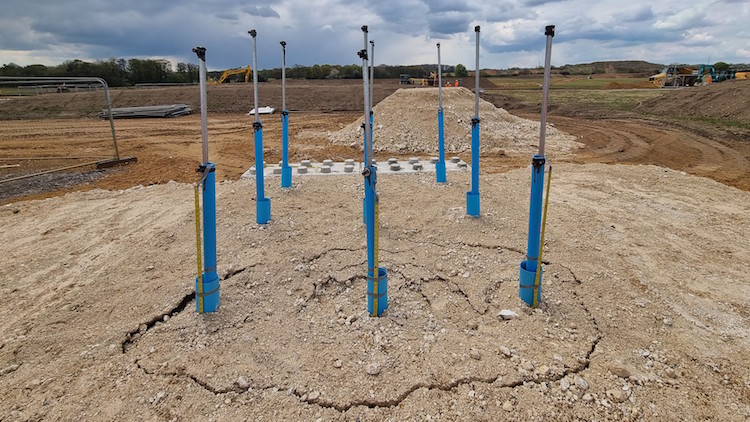
HS2 and the Align joint venture of Bouygues, Sir Robert McAlpine and Volker Fitzpatrick are testing fibre optic technology to detect minute ground movements in embankments and cuttings, and thus help prevent land slips.
The University of Cambridge’s Centre for Smart Infrastructure & Construction and geosynthetics manufacturer Huesker have created a standard ground-stabilising mesh woven with fibre optic cables, named Sensorgrid. It has been tested At HS2’s Chilterns tunnel south portal site by a team that includes Align’s designer, Jacobs, and infrastructure monitoring company, Epsimon, Together, they created a test pit at the site to trial the technology by simulating ground movement.
Heavy-duty water-filled bags were laid in the base of the pit and sections of Sensorgrid laid over it and then buried. Monitoring equipment then generated pulses of light that travelled through the fibre optic cable. To simulate ground movement, water was released from the bags, causing the weight of the ground above to move and strain the mesh, which in turn causes a change in characteristics of the light pulsing through it.
The successful trial showed that Sensorgrid can detect small ground movements earlier and more effectively than established ground monitoring techniques.
Preventative cost savings
The team estimates that on construction costs alone, proactive preventative action enabled by Sensorgrid would be up to 10 times less than the cost of repairing ground that has failed. The benefits of disruption reduced or avoided would be in addition to this saving.
The technology is undergoing a full-scale live trial elsewhere at HS2’s South Portal site near the M25. Two kilometres of Sensorgrid has been incorporated into a cutting for the railway and will provide continuous data to the monitoring team over the next two years.
HS2 Ltd innovation manager Rob Cairns said: “Sensorgrid is a great example of how we’re leveraging HS2’s size and scale to draw on British expertise to develop a technology and demonstrate its innovative capability in the early stages of construction. This will act as a test bed for proving significant benefit to the operational railway, with long term benefits in bolstering the resilience of the UK’s transport network.”
Align innovation manager Nick Podevyn said: “A lot of hard work has gone into this innovation, which has been in incubation for more than a year. It has been an exemplar of open collaboration and working as one team to deliver the solution. It’s fantastic to see the prototype being physically tested on our site and then the technology being implemented on the live project.”














